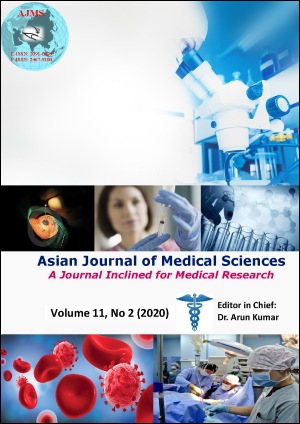The proportion hyperhomocysteinemia in chronic kidney disease patients
Keywords:
Chronic kidney disease, Hyperhomocysteinemia, Vitamin B combination, Cardiovascular diseaseAbstract
Background: Chronic kidney disease (CKD) patients often have a high homocysteine level Hyperhomocystinemia considered as one of cardiovascular disease risk factor in CKD patients. Studies concern on the proportion of hyperhomocysteinemia in patients with CKD in Indonesia are very limited.
Aims and Objectives: The main objective was to identify the proportion of hyperhomocysteinemia in CKD patients.
Materials and Methods: This was a cross sectional study. Subjects in this study were CKD patients with routine hemodyalisis two times per week. Five mililiters venous blood was collected before the first hemodyalisis. The blood was stored into tubes contain clot activator. Homocysteine level higher than 15.39 μmol/L considered as hyperhomocysteine.
Results: Total of 122 subjects included at this study. Subjects dominated by male with mean age of 51.7 years. Anemia (86.9%) and hypertension (86.1%) were the common comorbidities. Co-treatment assessed in this study i.e.: folic acid, calcium carbonat, antihypertensive agent, antidiabetic agent, antiplatelet agent, lipid lowering agent, and hematopoietic agent. The prevalence of hyperhomocysteinemia was high (89.3%) despite of the high consumption of folic acid in subjects (86.1%).
Conclusion: Hyperhomocysteinemia is a common condition among CKD patients with hemodyalisis.
Downloads
Downloads
Published
How to Cite
Issue
Section
License
Authors who publish with this journal agree to the following terms:
- The journal holds copyright and publishes the work under a Creative Commons CC-BY-NC license that permits use, distribution and reprduction in any medium, provided the original work is properly cited and is not used for commercial purposes. The journal should be recognised as the original publisher of this work.
- Authors are able to enter into separate, additional contractual arrangements for the non-exclusive distribution of the journal's published version of the work (e.g., post it to an institutional repository or publish it in a book), with an acknowledgement of its initial publication in this journal.
- Authors are permitted and encouraged to post their work online (e.g., in institutional repositories or on their website) prior to and during the submission process, as it can lead to productive exchanges, as well as earlier and greater citation of published work (See The Effect of Open Access).




